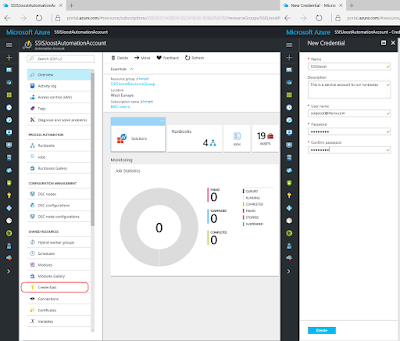There is an option to automatically shutdown your Azure Virtual Machine on a certain time, but where is the option to start it automatically?
 |
| Auto-shutdown Auzre VM |
Solution
At the time of writing there is no option in the menu to automatically start your Azure Virtual Machine. However with some PowerShell script in for example an Azure Automation Runbook you can start your machine with less than 10 lines of code (excluding comments and write-hosts).
Update January 5 2020: updated script with AZ modules
1) Create Automation Account
First we need an Azure Automation Account to run the Runbook with PowerShell code. If you don't have one or want to create a new one, then search for Automation under Monitoring + Management and give it a suitable name, then select your subscription, resource group and location. For this example I will choose West Europe since I'm from the Netherlands. Also make sure the Create Azure Run as account option is on (we need it for step 3).
 |
| Add Automation Account |
2) Credentials
Next step is to create Credentials to run this runbook with. This works very similar to the Credentials in SQL Server Management Studio. Go to the Azure Automation Account and click on Credentials in the menu. Then click on Add New Credentials. You could just use your own Azure credentials, but the best options is to use a service account with a non-expiring password. Otherwise you need to change this regularly.
 |
| Create new credentials |
3) Connections
This step is for your information only and to understand the code. Under Connections you will find a default connection named 'AzureRunAsConnection' that contains information about the Azure environment, like the tendant id and the subscription id. To prevent hardcoded connection details we will retrieve these fields in the PowerShell code.
 |
| Azure Connections |
4) Variables
An other option to prevent hardcoded values in your PowerShell code it to use Variables. We will use this option to provide the Resource Group name and the name of your Virtual Machine. Go to Variables and add a new variable for ResourceGroupName and add the name of the Resource Group that is used by your Virtual Machine as value. Then repeat this for the name of your Virtual Machine and call it VirtualMachineName.
 |
| Add variables |
5) Runbooks
Now it is time to add a new Azure Runbook for the PowerShell code. Click on Runbooks and then add a new runbook (There are already four example runbooks of which AzureAutomationTutorialScript could be useful as an example). Give your new Runbook a suitable name and choose PowerShell as type.
 |
| Add Azure Runbook |
6) Edit Script
After clicking Create in the previous step the editor will be opened. When editing an existing Runbook you need to click on the Edit button to edit the code. You can copy and paste the code below to your editor. Study the green comments to understand the code. Also make sure to compare the variable names in the code to the once created in step 4 and change them if necessary.
 |
| Edit the PowerShell code |
# PowerShell code # Connect to a connection to get TenantId and SubscriptionId $Connection = Get-AutomationConnection -Name "AzureRunAsConnection" $TenantId = $Connection.TenantId $SubscriptionId = $Connection.SubscriptionId # Get the service principal credentials connected to the automation account. $null = $SPCredential = Get-AutomationPSCredential -Name "SSISJoost" # Login to Azure ($null is to prevent output, since Out-Null doesn't work in Azure) Write-Output "Login to Azure using automation account 'SSISJoost'." $null = Login-AzureRmAccount -TenantId $TenantId -SubscriptionId $SubscriptionId -Credential $SPCredential # Select the correct subscription Write-Output "Selecting subscription '$($SubscriptionId)'." $null = Select-AzureRmSubscription -SubscriptionID $SubscriptionId # Get variable values $ResourceGroupName = Get-AutomationVariable -Name 'ResourceGroupName' $VirtualMachineName = Get-AutomationVariable -Name 'VirtualMachineName' Write-Output "Starting Virtual Machine" $null = Start-AzureRmVM -ResourceGroupName $ResourceGroupName -Name $VirtualMachineName Write-Output "Done"
Note 1: This is a very basic script. No error handling has been added. Check the AzureAutomationTutorialScript for an example. Finetune it for you own needs.
Note 2: Because Azure Automation doesn't support Out-Null I used an other trick with the $null =. However the Write-Outputs are for testing purposes only. Nobody sees them when they are scheduled.
Note 3: When starting multiple Virtual Machines at once then make sure to start them in parallel instead of sequential to reduce the runtime of your runbook.
7) Testing
You can use the Test Pane menu option in the editor to test your PowerShell scripts. When clicking on Run it will first Queue the script before Starting it. Running takes a couple of minutes.
 |
| Testing the script in the Test Pane |
8) Publish
When your script is ready, it is time to publish it. Above the editor click on the Publish button. Confirm overriding any previously published versions.
 |
| Publish the Runbook |
And now that we have a working and published Azure Runbook, we need to schedule it. Click on Schedule to create a new schedule for your runbook. For this start up script I created a schedule that runs every working day on 7:00AM (07:00). Now you need to hit the refresh button in the Virtual Machine overview in Azure to see if it really works. It takes a few minutes to run, so don't worry too soon.
 |
| Add Schedule |
Summary
In this post you saw how you can start an Azure Virtual Machine with PowerShell because the menu only supports auto-shutdown. With just a few lines of code and a schedule you can accomplish an auto-startup.
With a webhook you could also call this runbook with PowerShell script from other applications. For example the Microsoft Flow App on your mobile.